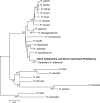Isolation of Rickettsia parkeri and identification of a novel spotted fever group Rickettsia sp. from Gulf Coast ticks (Amblyomma maculatum) in the United States
- PMID: 20208020
- PMCID: PMC2863434
- DOI: 10.1128/AEM.02737-09
Isolation of Rickettsia parkeri and identification of a novel spotted fever group Rickettsia sp. from Gulf Coast ticks (Amblyomma maculatum) in the United States
Abstract
Until recently, Amblyomma maculatum (the Gulf Coast tick) had garnered little attention compared to other species of human-biting ticks in the United States. A. maculatum is now recognized as the principal vector of Rickettsia parkeri, a pathogenic spotted fever group rickettsia (SFGR) that causes an eschar-associated illness in humans that resembles Rocky Mountain spotted fever. A novel SFGR, distinct from other recognized Rickettsia spp., has also been detected recently in A. maculatum specimens collected in several regions of the southeastern United States. In this study, 198 questing adult Gulf Coast ticks were collected at 4 locations in Florida and Mississippi; 28% of these ticks were infected with R. parkeri, and 2% of these were infected with a novel SFGR. Seventeen isolates of R. parkeri from individual specimens of A. maculatum were cultivated in Vero E6 cells; however, all attempts to isolate the novel SFGR were unsuccessful. Partial genetic characterization of the novel SFGR revealed identity with several recently described, incompletely characterized, and noncultivated SFGR, including "Candidatus Rickettsia andeanae" and Rickettsia sp. Argentina detected in several species of Neotropical ticks from Argentina and Peru. These findings suggest that each of these "novel" rickettsiae represent the same species. This study considerably expanded the number of low-passage, A. maculatum-derived isolates of R. parkeri and characterized a second, sympatric Rickettsia sp. found in Gulf Coast ticks.
Figures



References
-
- Baldridge, G. D., N. Y. Burkhardt, M. B. Labruna, R. C. Pacheco, C. D. Paddock, P. C. Williamson, P. M. Billingsley, R. F. Felsheim, T. J. Kurtti, and U. G. Munderloh. 2010. Wide dispersal and possible multiple origins of low-copy-number plasmids in Rickettsia species associated with blood-feeding arthropods. Appl. Environ. Microbiol. 76:1718-1731. - PMC - PubMed
-
- Bell, E. J., and E. G. Pickens. 1953. A toxic substance associated with the rickettsias of the spotted fever group. J. Immunol. 70:461-472. - PubMed
-
- Bishopp, F. C., and H. Hixson. 1936. Biology and economic importance of the Gulf Coast tick. J. Econ. Entomol. 29:1068-1076.
MeSH terms
LinkOut - more resources
Full Text Sources
Miscellaneous

